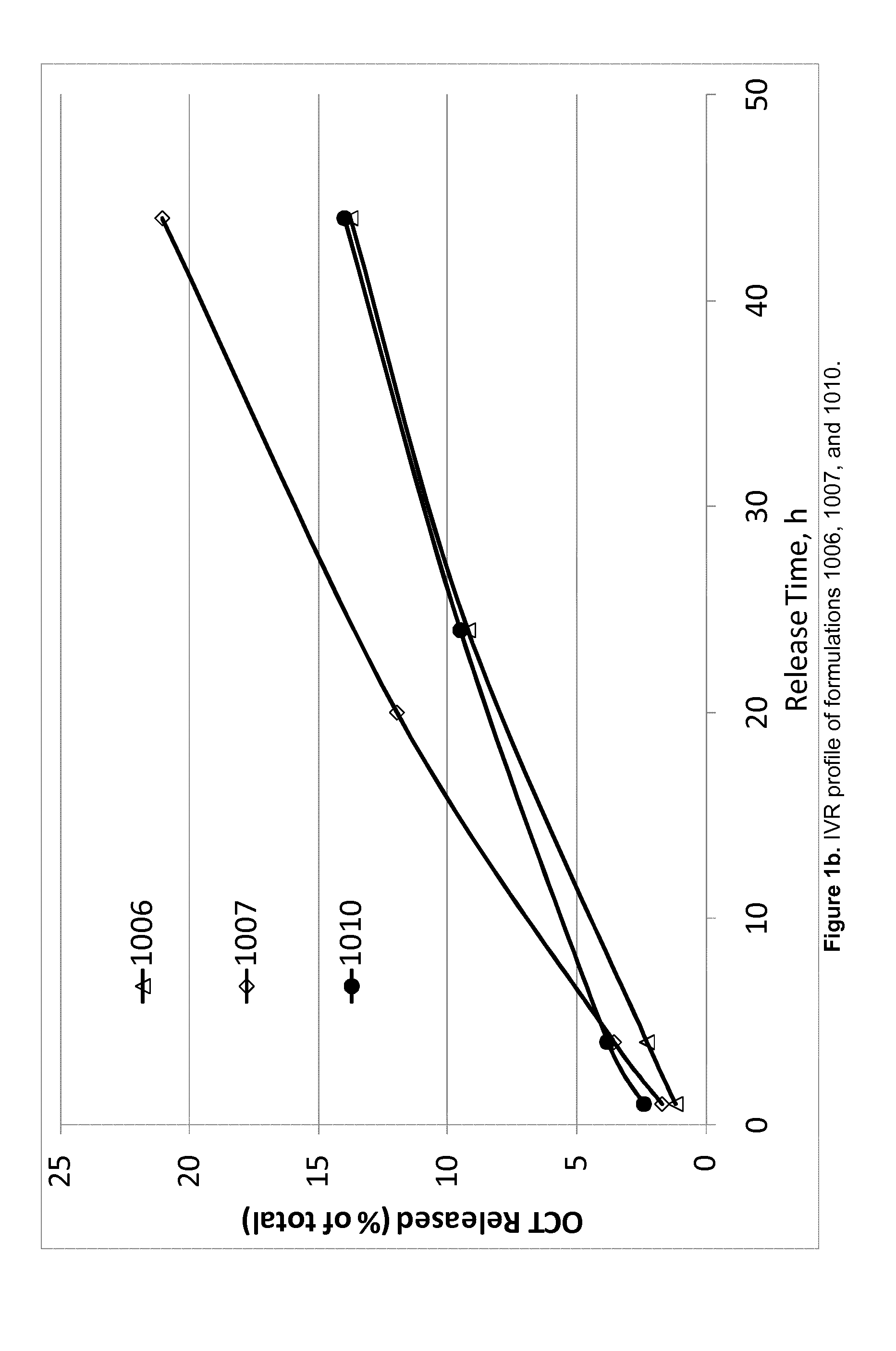Controlled release peptide formulations
a technology of peptides and peptides, applied in the field of formulation precursors, can solve the problems of poor compliance, unsatisfactory or even dangerous effects, and general limited performance of administered peptide agents, and achieve the effect of little or no preparation
- Summary
- Abstract
- Description
- Claims
- Application Information
AI Technical Summary
Benefits of technology
Problems solved by technology
Method used
Image
Examples
example 1
Manufacturing of OCT-Containing Products
[0242]
TABLE 1Composition of OCT-containing products.OCTEDTA-FormulationIngredient(Cl)SPCGDOEtOHPGwater1)A(wt %)2.4443.7843.785.005.00—B(wt %)2.4442.2842.286.506.50—C(wt %)2.4445.5345.536.50——D(wt %)2.4438.7838.7810.00—10.00E(wt %)2.4433.7833.7815.00—15.001)The concentration in the solution is 0.10 mg EDTA / mL; this solution was prepared by mixing 10 mg EDTANa2 in water.
[0243]Depot precursors with the compositions presented in Table 1 were manufactured by first preparing a peptide stock, by weighing the ingredients as described in Table 2 and mixing on a shaking table (250-300 rpm) to homogeneous solutions.
TABLE 2Preparation of peptide stock solutions.FormulationIngredientOCT(Cl)EtOHPGEDTA-waterA(g)2.445.005.00—B(g)2.446.506.50—C(g)2.446.50——D(g)2.56——10.50E(g)0.28—— 1.73
[0244]For manufacturing of A, B and C, the following amounts (Table 3) of SPC and GDO were weighted directly into the recipient containing the OCT(Cl) stock solution.
TABLE 3Amou...
example 2
In-Vitro Release from OCT-Containing Products
[0248]Formulations with the composition presented in Table 4 were manufactured by first preparing the corresponding OCT(Cl) stock solutions in EtOH, EtOH:PG mixture or respectively water (as described in Example 1 above), followed by mixing with the other components until homogeneous solutions were obtained.
TABLE 4Composition of OCT-containing products evaluated in the acceleratedin vitro release (IVR) experiment.OCTFormulationIngredient(Cl)SPCGDOEtOHPGWater911(wt %)2.4343.7243.795.025.04912(wt %)2.4342.0842.136.566.81913(wt %)2.4341.2641.237.517.58914(wt %)2.4345.4145.606.56916(wt %)2.4333.7033.7315.0915.06917(wt %)2.4438.7038.6810.0410.14918(wt %)3.6433.0833.0715.0815.131006(wt %)2.0041.4841.487.557.491007(wt %)2.0036.4936.4912.5012.531010(wt %)2.0038.9638.9510.129.97
[0249]Evaluation of accelerated IVR of OCT from each of the formulations presented above was carried out by injecting approximately 100 mg (±20%) into a glass vial containi...
example 3
Stability of OCT-Containing Products with Vs. without EDTA
[0251]A formulation (batch size 110 g) with the composition OCT(Cl) / SPC / GDO / EtOH 3.74 / 43.13 / 43.13 / 10.00 (all in wt %) was manufactured by first dissolving 4.114 g OCT(Cl) in 11.000 g EtOH, followed by sequential addition of 47.433 g SPC and 47.433 g GDO, and mixing to a homogeneous solution (91).
[0252]One sample (G) containing 3.37 wt % OCT(Cl) (approximately 2.98 wt % OCT base) by mixing 0.9 g formulation 91 with 0.1 mg of a solution containing 0.1 wt % of EDTA in HPLC-grade water.
[0253]One sample (H) containing 3.37 wt % OCT(Cl) was prepared by mixing 0.9 g formulation 91 with 0.1 mg HPLC-grade water.
[0254]The samples were divided each into two aliquots of about 0.4 g / vial; one aliquot / sample was incubated at 70° C., whereas the other was placed at <−15° C. (reference). All samples were analysed after 7 days of incubation in the above-mentioned conditions by using a normal-phase HPLC (analytical column LiChrospher Diol 5 μm...
PUM
| Property | Measurement | Unit |
|---|---|---|
| pH | aaaaa | aaaaa |
| pH | aaaaa | aaaaa |
| concentration | aaaaa | aaaaa |
Abstract
Description
Claims
Application Information
 Login to View More
Login to View More - R&D
- Intellectual Property
- Life Sciences
- Materials
- Tech Scout
- Unparalleled Data Quality
- Higher Quality Content
- 60% Fewer Hallucinations
Browse by: Latest US Patents, China's latest patents, Technical Efficacy Thesaurus, Application Domain, Technology Topic, Popular Technical Reports.
© 2025 PatSnap. All rights reserved.Legal|Privacy policy|Modern Slavery Act Transparency Statement|Sitemap|About US| Contact US: help@patsnap.com



